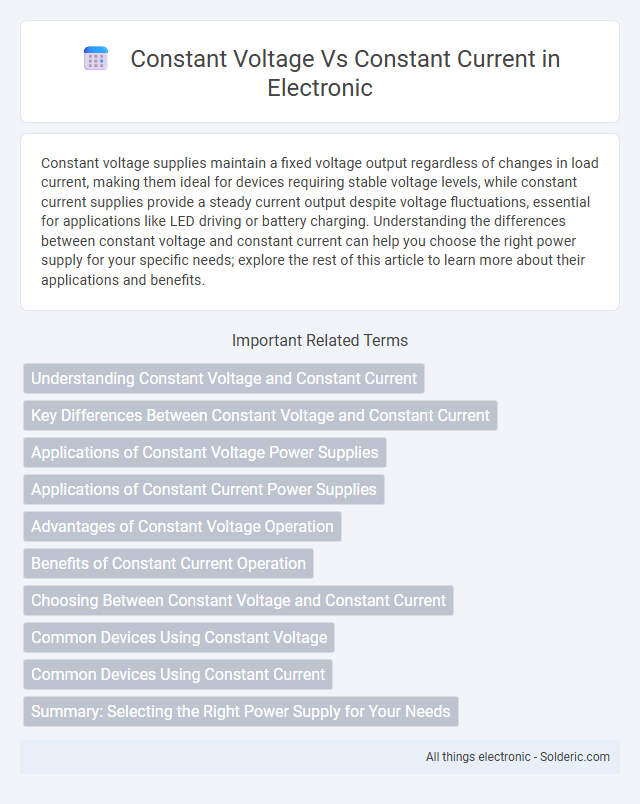Constant voltage supplies maintain a fixed voltage output regardless of changes in load current, making them ideal for devices requiring stable voltage levels, while constant current supplies provide a steady current output despite voltage fluctuations, essential for applications like LED driving or battery charging. Understanding the differences between constant voltage and constant current can help you choose the right power supply for your specific needs; explore the rest of this article to learn more about their applications and benefits.
Comparison Table
| Feature | Constant Voltage | Constant Current |
|---|---|---|
| Definition | Maintains fixed voltage output regardless of load changes | Maintains fixed current output regardless of load changes |
| Primary Use | Power supplies for electronics, LED strips with series wiring | Battery charging, LED drivers with parallel wiring |
| Load Dependency | Current varies based on load resistance | Voltage varies based on load resistance |
| Protection | Overcurrent protection required to prevent damage | Overvoltage protection needed |
| Efficiency | Efficient for devices designed for stable voltage | Efficient for devices requiring precise current control |
| Example Devices | DC power adapters, wall chargers | LED constant current drivers, battery chargers |
Understanding Constant Voltage and Constant Current
Constant voltage supplies maintain a fixed voltage output regardless of changes in load current, making them ideal for powering devices like LEDs and batteries that require a steady voltage level. Constant current supplies deliver a stable current output, adjusting the voltage as needed, which is crucial for applications such as LED drivers and battery chargers to prevent damage from overcurrent. Understanding these differences helps you select the appropriate power source for your electronic circuits, ensuring optimal performance and safety.
Key Differences Between Constant Voltage and Constant Current
Constant voltage maintains a fixed voltage level regardless of changes in current, making it ideal for powering devices like LEDs that require stable voltage input. Constant current ensures a steady current flow by adjusting the voltage as needed, commonly used in battery charging and LED drivers to protect sensitive components. Understanding these key differences helps you choose the right power supply for your electronic applications, ensuring safety and optimal performance.
Applications of Constant Voltage Power Supplies
Constant voltage power supplies are widely used in applications such as LED lighting, battery charging, and electronic testing where a stable voltage output is crucial for device performance and safety. These power supplies ensure consistent voltage delivery despite varying load conditions, making them ideal for powering sensitive electronics and circuits that require precise voltage regulation. Industries like telecommunications, medical equipment manufacturing, and consumer electronics heavily rely on constant voltage sources for reliable operation and optimal device lifespan.
Applications of Constant Current Power Supplies
Constant current power supplies are essential in applications requiring stable current regardless of voltage fluctuations, such as battery charging, LED driving, and electroplating. These power supplies ensure precise current regulation to protect sensitive components and maintain optimal performance in medical devices, industrial equipment, and laboratory instruments. Your projects involving semiconductor testing or laser diode operation benefit significantly from the consistent current delivery provided by constant current power supplies.
Advantages of Constant Voltage Operation
Constant voltage operation provides precise voltage regulation, ensuring stable power supply for sensitive electronic devices and circuits. It enables consistent performance, reduces the risk of damage from voltage fluctuations, and simplifies compatibility with various loads, making it ideal for LED lighting and battery charging applications. Your equipment benefits from enhanced safety and extended lifespan due to maintained voltage levels.
Benefits of Constant Current Operation
Constant current operation ensures a stable and precise power supply to electronic devices, preventing damage caused by voltage fluctuations and overcurrent conditions. It is especially beneficial for LED lighting, battery charging, and power supplies where maintaining consistent current improves efficiency and extends component lifespan. This approach enhances system reliability and safety by minimizing thermal stress and optimizing energy consumption.
Choosing Between Constant Voltage and Constant Current
Choosing between constant voltage and constant current depends on the specific requirements of the load and application. Constant voltage is ideal for devices needing a stable voltage supply, such as LEDs or low-voltage power systems, ensuring consistent brightness and performance. Constant current suits applications requiring a consistent current flow, like battery charging or LED driving, preventing damage and optimizing device longevity.
Common Devices Using Constant Voltage
Common devices using constant voltage include LED lighting systems, smartphones, and computer monitors, which require stable voltage to maintain optimal performance and prevent damage. Power supplies for these devices regulate voltage output precisely to ensure consistent brightness, safe charging, and reliable operation. Your electronic equipment benefits from constant voltage sources by experiencing enhanced longevity and stable functionality.
Common Devices Using Constant Current
Common devices using constant current include LED lighting systems, battery chargers, and certain types of power supplies for sensitive electronics. These devices rely on maintaining a steady current to ensure consistent performance, prevent damage, and increase lifespan. Constant current drivers are essential in applications where voltage may vary but current stability is critical for proper operation.
Summary: Selecting the Right Power Supply for Your Needs
Choosing between constant voltage and constant current power supplies depends on the specific application requirements; constant voltage supplies maintain a fixed voltage output ideal for devices like LEDs and electronic circuits, while constant current supplies deliver a steady current, crucial for battery charging and laser diodes. Understanding the load characteristics and ensuring the power supply matches the device's specifications prevents damage and enhances performance. Careful assessment of voltage stability and current regulation helps optimize efficiency and reliability in electronic systems.
Constant voltage vs Constant current Infographic

 solderic.com
solderic.com